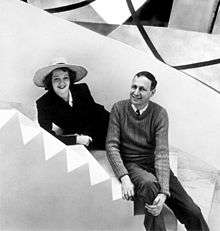Suzy Frelinghuysen
| Suzy Frelinghuysen | |
|---|---|
 Suzy Frelinghuysen and George L. K. Morris | |
| Born |
Estelle Condit Frelinghuysen May 7, 1911 Newark, New Jersey |
| Died |
March 19, 1988 (aged 76) Lenox, Massachusetts |
| Nationality | American |
| Known for | Painting, Music |
| Movement | Modernism, Abstraction, Cubism |
Suzy Frelinghuysen (May 7, 1911 – March 19, 1988), also known as Suzy Morris, was an American abstract painter and opera singer.[1]
Early personal life
Born to a prominent family in Newark, New Jersey, Suzy was daughter of Frederick Frelinghuysen (1848-1936) and his wife Estelle B. Kinney, who were married in 1902. She descended from various politicians, including her grandfather, Frederick T. Frelinghuysen (Secretary of State under Chester A. Arthur), and her great-great-uncle, Theodore Frelinghuysen (Senator from New Jersey). She was educated at Miss Fine's school in Princeton, and later studied voice.[2] She displayed an early interest in painting and drawing but never undertook formal art studies.[3]
Artistic career
Painting
Her paintings were done in a realist style until the time of her marriage to abstract painter and collector George L.K. Morris in 1935. Morris introduced her to the work of European modernists like Pablo Picasso, Fernand Léger, Georges Braque, and Juan Gris, which inspired her to explore a more abstract Cubist manner.[3]
In 1938 she became the first woman to have a painting placed in the permanent collection of A.E. Gallatin's Museum of Living Art. She and Morris were founding members of the American Abstract Artists. She took part, in Paris, at the Salon des Réalités Nouvelles, and exhibited also in Rome and Amsterdam.
Opera
As Suzy Morris, the dramatic soprano appeared with the New York City Opera from 1947 to 1950, in Ariadne auf Naxos (in the title role, opposite Virginia MacWatters as Zerbinetta), Cavalleria rusticana (as Santuzza, conducted by Julius Rudel), Tosca (as Floria Tosca), Aïda (as Amneris, with Camilla Williams, Ramón Vinay, and Lawrence Winters, directed by Theodore Komisarjevsky), and Les contes d'Hoffmann (as Giulietta).
Following that last appearance with the City Opera, she debuted in 1950 with the New Orleans Opera Association, as Amelia in Un ballo in maschera. That performance, which was broadcast, also featured Jussi Björling, Marko Rothmüller, Martha Larrimore, the young Norman Treigle (as Samuele), as well as Audrey Schuh (as Oscar, her first major role). In 1998, VAI released this performance on compact disc.
After a 1951 bout of bronchitis, the soprano retired from the stage, and once more became a full-time painter.
Legacy
Suzy Frelinghuysen died in Lenox, Massachusetts.
Her work can be viewed in the collections of the Metropolitan Museum of Art, the Philadelphia Museum of Art, the Smithsonian American Art Museum, the Carnegie Art Institute, and her home and studio museum in Lenox, Massachusetts.[4]
References
- The New York City Opera: An American Adventure, by Martin L. Sokol, Macmillan Publishing Co, Inc, 1981. ISBN 0-02-612280-4
Notes
- ↑ Victoria Etnier Villamil (2004). From Johnson's Kids to Lemonade Opera: The American Classical Singer Comes of Age. UPNE. p. 273. ISBN 978-1-55553-635-0.
- ↑ "Suzy Frelinghuysen, Artist, Is Dead at 76". New York Times. March 23, 1988. Retrieved 5 May 2014.
- 1 2 "Suzy Frelinghuysen - Artist Biography". Smithsonian American Art Museum. Retrieved 5 May 2014.
- ↑ "About". Frelinghuysen Morris House and Studio. Retrieved 2015-07-05.
External links
- Official web-site: frelinghuysen.org
- Suzy Morris and Jussi Björling in an excerpt from Un ballo in maschera (1950).
- Painting: "Composition--Toreador Drinking," 1944, by Suzy Frelinghuysen, in the Smithsonian American Art Museum
- "Suzy Frelinghuysen (1911–1988)". New York University.